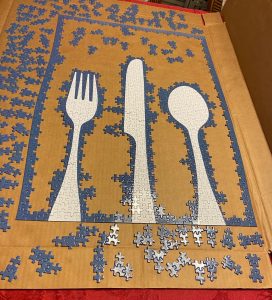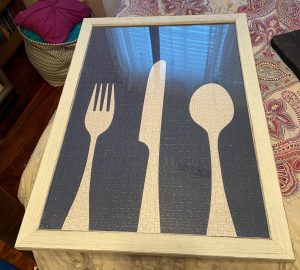Puzzles and Blank Screens
By Hope, a Writing Center Coach
The clock was ticking. I had gone home for Winter Break, and my sister had given me a Christmas present, a jigsaw puzzle intended to hang in my admittedly bare apartment. It was a great idea in theory, but now I felt as though I had a task to complete before returning to my apartment. Worse, the puzzle was almost all blue, besides a white fork, spoon, and knife at the bottom. I am not new at piecing together jigsaw puzzles, but solid-color ones were a feat I had yet to tackle. I felt intimidated but obligated to try.
At first, it was easy enough. The day I received the puzzle, my family and I matched the edge pieces and the white utensils. But then we were faced with a box of solely blue puzzle pieces, all almost the exact same shape besides a few that we had already matched and left on the table.


Determined, we sat down to strategize. We researched how-to videos, looked for slight color variations in the pieces, and searched for patterns. Few of these ideas worked. In essence, every piece could have matched another, thus requiring us to try every possible combination to complete the puzzle.
It looked impossible, and for all we knew, it was impossible. So we quit. The puzzle sat untouched on our dining room table as we went about our lives, normal obligations, and holiday excitement.
Returning to classes this semester and being faced with unfamiliar writing assignments, I have found that piecing together solid-color jigsaw puzzles is much like writing papers. At first, I am eager to try it, but then, even though I have plenty of writing experience, I find myself gazing wide-eyed into the abyss of paper prompts and blank Microsoft Word documents unsure what to write or where to start. It feels like an intimidating puzzle I do not know how to solve, and my motivation dwindles until I set the paper aside in favor of other obligations.
Yet, whenever I quit something, I naturally feel like I must return to finish it. For the puzzle, one day over the break, I resigned myself to at least trying a piece. I chose one and committed, trying it with every other piece until I found a match. Suddenly, just by trying a single piece, I realized that the impossible was not actually impossible. Through a snowball effect of motivation, my family and I continued filling in pieces, finishing the puzzle two weeks later.

The completed blue and white puzzle sitting on the kitchen table.
With the puzzle that is paper-writing, I must also overcome the challenge of considering the task too impossible to start. I have to sit down, commit to at least writing a sentence, and then I am propelled through the rest of the paper. The blanks fill in until I have a full document of cohesive words ready to eventually submit.
Here are some of the strategies that I use when writing, strategies that also motivated me to do the “impossible” puzzle:
- I strategize and set target deadlines. Just like with the puzzle, I usually make a game plan when writing papers. I like knowing what I want to do and when. I write target deadlines with each task (down to the minute, such as 8:55 PM) to motivate myself to finish the paper in advance of the due date. I convince myself that this new (early) due date is the actual deadline, so I must have it done by then. Afterwards, I reward myself with a snack (mug cakes are currently my favorite—quick and easy) while watching YouTube or television.
- I start early. It is easier said than done when writing, but if I had not started the puzzle three weeks before I needed it done, I never would have finished. Similarly, I almost never start a paper in the same week (let alone the same day) as I plan to submit it.
- I plan out my priorities: Unlike the puzzle, which did not have a real-life due date (besides my self-prescribed one), my writing assignments often have strict due dates that I have to meet. Knowing this, I set target deadlines for my paper. I add my other commitments (like jobs or time with friends and family) with their own time limits. I give more time to the high priority items on my to-do list. A resource that helps me to plan my priorities is the Learning Center’s Priorities Worksheet. Seeing my commitments lined up like this allows me to see the maximum amount of time I have for each and how much I have to accomplish. The worry induced by the looming deadlines is usually incentive enough for me to begin working.
- I limit distractions: Although I enjoyed listening to music for motivation as I filled in the puzzle, music—or relatively any noise—is a distraction for me as I write. Therefore, I often turn off my television, sit in the quiet of my apartment, and put away my phone while writing papers, especially those of peak impossibility (which make scrolling through my library of music so much more enticing). Knowing what works for me personally in different situations helps me to be most productive and engaged, ready to face the impossible. Or as ready as I’ll ever be. For more on knowing what works for me, I learned a lot of helpful questions to ask myself from the In Physical Space Check (How I Optimized My Work) blog post.
- I reach out to people who care about me. Similar to having my family help find puzzle pieces, I often find that calling my twin sister to productively discuss (and sometimes rant) about papers I am struggling with helps me to brainstorm topics and formulate my ideas. If not family, I always know that I can schedule a Writing Center appointment to discuss my ideas at any point in the writing process if I get stuck.
- I connect with people with more experience in the topic. Just like when I researched advice for completing solid-color puzzles, something I almost always try to do when writing a paper is email or meet with my professor during office hours after I draft my thesis. Often, this pushes me to think harder about what I actually want to write about, and asking my professor questions allows me to think through roadblocks I stumble upon as I write. While this step can be somewhat intimidating for me, the professors and TAs I have met with have always been helpful and encouraging.
- I take a break: If there is anything I learned from doing the puzzle, it is that sometimes I have to step away from something for a little while in order to finish it later. My schedule of deadlines often includes incremental breaks so I can relax and revisit the paper with new(er), more motivated eyes. These breaks usually occur at natural pauses in my writing process (for example, between outlining my paper and starting the first draft, or between finishing my final draft and rereading it).
- I just do it: Nike said it best. If there is no time for breaks, sometimes I have to just do it. I focus on reminding myself that the more words I add to the page, the more metaphorical puzzle pieces I am putting together.
Like with my jigsaw puzzle, the thought—or fear—of writing tends to be more difficult to me than actually writing. Yet, by following my strategies, I am able to believe in myself and my capacity to complete the task. With newfound confidence and a leap of faith, I can start the process and complete the puzzle. As Nelson Mandela said, “It always seems impossible until it’s done.”

This blog showcases the perspectives of UNC Chapel Hill community members learning and writing online. If you want to talk to a Writing and Learning Center coach about implementing strategies described in the blog, make an appointment with a writing coach, a peer tutor, or an academic coach today. Have an idea for a blog post about how you are learning and writing remotely? Contact us here.

